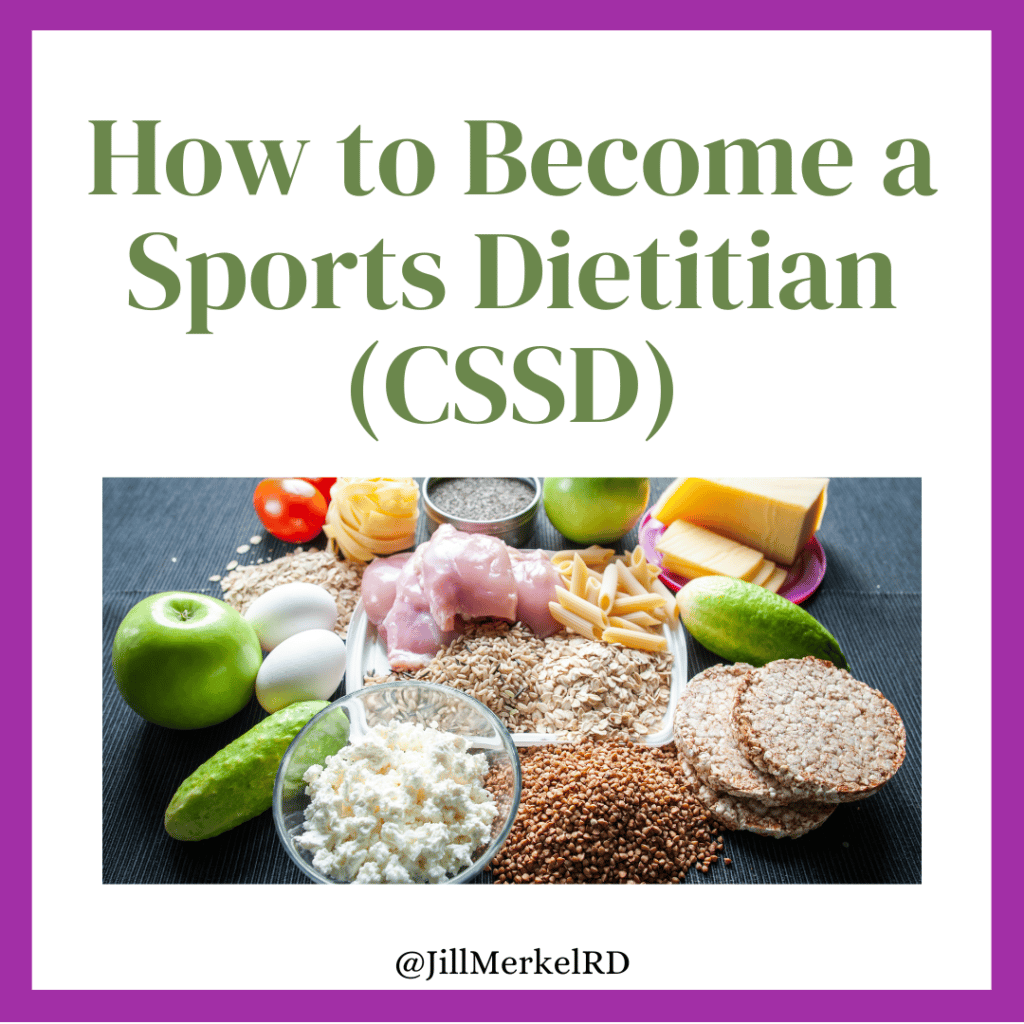This post is going to tell you how to become a sports dietitian (CSSD). Including: The difference between a dietitian and a nutritionist; how to become a Registered Dietitian (RD); how to become a Sports Dietitian (CSSD); Sports Dietitian Jobs; and Sports dietitian salary information.
Let’s dive in!

Difference between a dietitian and a nutritionist
First, I want to clarify the difference between a dietitian and a nutritionist.
This is a commonly asked question and a common misperception. A Registered Dietitian (RD) aka dietitian is considered the food and nutrition experts. To become an RD (more below), you must obtain a bachelor’s degree, a 6-12 month supervised practice (dietetic internship), pass the national RD exam, and maintain continuing professional education requirements to maintain your RD credential.
Whereas a nutritionist is well, anyone who wants to call themselves a nutritionist. Sadly, there is no requirement to be a nutritionist and therefore, it is not recommended that you work with a nutritionist. There are online programs and courses that sometimes people take before calling themselves a nutritionist, but not always.
If you want individualized nutrition recommendations, you must seek out and work with a Registered Dietitian. It is unethical and illegal for a non-RD (aka nutritionist, health coach, personal trainer, etc.) to provide individual nutrition recommendations. A non-RD can give general health information such as eat more fruits and vegetables, or hydration before, during, and after a workout.
How to become a Registered Dietitian (RD)
The road to become a Registered Dietitian includes a bachelor’s degree in nutrition or dietetics. (Sometimes your bachelor’s degree can be in something else, depending on your next step).
Then, you have to fulfill the RD requirements, set by the Academy of Nutrition and Dietetics (AND), by completing a dietetic internship. This requires 1,200 hours of practical experience. The dietetic internship may be part of a master’s degree program such as the Coordinate Master’s Program I completed at the University of Utah.
The Academy of Nutrition and Dietetics (AND) is changing the RD requirements to include a master’s degree beginning in January 2024.
Once you have completed your dietetic internship, you sit for the RD exam. Once you pass the RD exam, you’ll need to complete continuing education (CEUs) in order to retain the RD credential. The CEUs for RDs are 75 credits every 5 years.
Now that you are a Registered Dietitian, you can begin working as an RD.
There are many work settings that an RD can work in, including but not limited to:
- Clinical (hospital, etc.)
- Community and public health (WIC, schools, etc.)
- Food service (Cafeteria, etc.)
- Education (teaching, research, etc.)
- Private practice
- Media
- Grocery stores
- Corporate wellness (Private corporations, etc.)
- Sports nutrition (High school, college, professional, etc.)
How to become a Sports Dietitian (CSSD)
Now let’s talk about how to become a sports dietitian and work in sports nutrition. If your goal is sports nutrition, you can work towards your Certified Specialist in Sports Dietetics (CSSD) credential.
The CSSD requires you to be an RD for at least 2 years. You also need 2,000 hours of sports nutrition experience. Once you have completed these requirements, you can sit for the CSSD exam.
Once you pass the CSSD exam, you’ll need to maintain continuing education (CEUs) and re-certify every 5 years.
Sports Dietitian Jobs
There are many different sports dietitians jobs and areas that a sports dietitian can work.
Sports Dietitian Jobs include but are not limited to:
- High school athletics
- Collegiate athletics
- Professional sports teams
- Olympic sports teams
- Military services
- Private sports performance (such as EXOS or Memorial Hermann IRONMAN Sports Medicine Institute)
- Private practice
You can find a list of full-time sports dietitians working in collegiate athletics, with professional sports teams, with Olympic athletes and within the U.S. military on CPSDA’s full-time sports dietitians page.
Sports Dietitian Salary
If you have chosen a career in sports nutrition, you may be wondering how much a sports dietitian makes or what the average salary might be like.
Like many career choices, the sports dietitian salary range is quite broad. CPSDA also gathers data and puts out a sports dietitian salary survey.
If you are just getting started in the sports nutrition field, you may need to take a lower-paying position such as a Sports Nutrition Immersion Program (SNIP) internship, a non-SNIP internship, a graduate assistant (GA) position, or a fellowship position.
These experience offer you hands-on experience plus mentoring and supervision from a veteran sports dietitian. They are usually short-term or temporary positions designed to give you experience that can then be applied to your next career opportunity.
Once you are a more experienced sports dietitian, you may expect a salary range as described below.
The CPSDA 2022 Sports Dietitian Salary Survey:
- Full-time sports dietitian role median annual salary: $73,000
- Collegiate sports dietitian median annual salary: $65,000
- Professional sports dietitian median annual salary: $80,000
- NFL sports dietitian median annual salary: $130,000
- UFC sports dietitian median annual salary: $122,500
- NBA sports dietitian median annual salary: $120,000
- NHL sports dietitian median annual salary: $82,000
- MLB sports dietitian median annual salary: $72,500
- MLS sports dietitian median annual salary: $68,000
- Tactical sports dietitian median annual salary: $84,000
- 16% salary increase from 2018 to 2022
- The lowest sports dietitian median annual salary on the report was $20,000 for a collegiate fellow sports RD
- The highest sports dietitian median annual salary on the report was $174,500 for a professional sports RD
So there you have it! All you need to know about how to become a sports dietitian.
You can see that the path to become an RD and a CSSD are extensive. The sports dietitian field is still relatively new and rapidly growing so I believe more and more jobs will become available and there is always room to advocate and create a position for yourself in a setting that needs a sports RD and doesn’t yet have one.
Getting experience is the number one recommendation when it comes to being a sports dietitian. Where you have worked, what responsibilities and roles you have had, and who you have worked with will go a long way in this field.
Also, attending conferences such as CPSDA’s annual conference and networking with sports dietitians is a great way to meet people and stay current in the sports nutrition realm.
Reflection Questions:
- What attracted you to the field of sports nutrition?
- What are your career goals for working in sports nutrition? Things to consider: type of athletes you want to work with, job setting, salary level, work/life balance, etc.
- What are you currently doing or have done to get experience in the field of sports nutrition?
- What surprised you most about how to become a sports dietitian?
Additional Sports Dietitian Resources
Mentoring/Supervision – I provide supervision, mentoring and career coaching for dietitians. I provide expertise in the area of sports nutrition, disordered eating, and Intuitive Eating. My sports nutrition career experience includes collegiate, private sports performance, private practice, NBA G-league, and NFL. You can view my full bio HERE.
Collegiate and Professional Sports Dietitians Association (CPSDA) – the go-to resource for anyone wanting to work in collegiate or professional sports nutrition.

